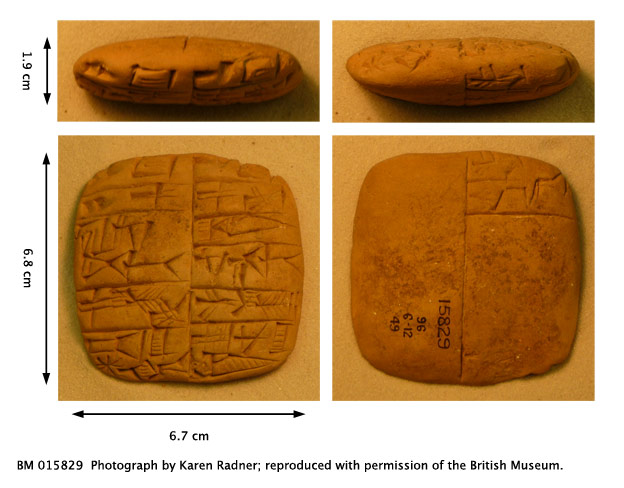BM 015829: administrative account of textiles, probably from Fara

BM 015829: administrative account of textiles, probably from Fara (Pre-Sargonic (ED IIIa) period, c.2500 BC). Photograph by Karen Radner; reproduced with permission of the British Museum. View large image.
The cuneiform of the mid-third millennium BC had come a long way since its infancy in Uruk (see BM 116625 and BM 116628). The number of characters in the script had more or less halved to around 800 signs. The form of the signs had also changed significantly; the pictographic quality of the archaic signs was lost. Each sign was made up of fewer strokes, curves had given way to straight lines, and by this time the script is unmistakably cuneiform; a reed stylus had pressed wedges into the clay. These wedges were carefully made but still rather large.
Like this tablet accounting for textiles, most documents were still concerned with administration; and lexical lists still formed a significant minority. But now the power of writing was harnessed in new directions. We see the first literature, religious and magical texts and an increasing number of royal inscriptions. We also find the first incontrovertible evidence for the syllabic use of signs and for the language being written – Sumerian.
An intriguing feature of mid-third millennium cuneiform is the so-called UD.GAL.NUN orthography (spelling practice), found mostly in mythological texts (and not in the tablet illustrated here). While the nature and origins of UD.GAL.NUN remain uncertain, some of the mechanisms are clear enough, Signs in the standard orthography are replaced by others according to a variety of rationales: sometimes the replacement sign is similar in appearance, sometimes similar in sound or meaning. The name UD.GAL.NUN itself derives from the common writing of the name of the chief god Enlil, usually written 𒀭 𒂗 𒆤 den-lil2 in Sumerian. In UD.GAL.NUN writing, however, 𒌓 UD replaces 𒀭 DINGIR, 𒃲 GAL replaces 𒂗 EN, and 𒉣 NUN replaces 𒆤 LIL2, so that 'Enlil' is written 𒌓 𒃲 𒉣. (Ensure that your cuneiform font is switched to OB.) This fascinating experiment did not endure.
For more online photos, view the record for this tablet on the CDLI website.
Content last modified on 12 Apr 2024.
Jon Taylor
Jon Taylor, 'BM 015829: administrative account of textiles, probably from Fara', Knowledge and Power, Higher Education Academy, 2024 [http://oracc.museum.upenn.edu/saao/knpp/cuneiformrevealed/tabletgallery/bm015829/]